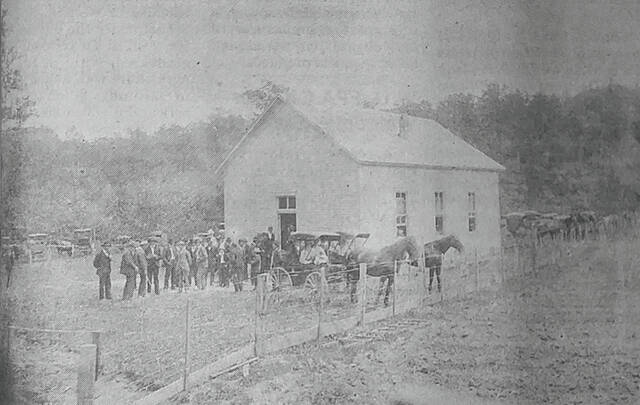
Pictured is an early view of the Lick Fork Church of the United Brethren in Christ. Taken by Lizzie Treber, this view shows a large gathering and was possibly taken at the dedication services held for the church building in 1900.
People’s Defender Archvies
September 19, 1985
By Stephen Kelley
About two miles north of West Union on the old Zane Trace site a forlorn, dilapidated structure on the east side of the road. This is in the Ghost Hollow section of the old road and although most of the cliffs on the west side of the highway have been removed in recent years for road relocation, the natural outcroppings of stone are clearly visible on the east bank of the Lick Fork which parallels the roadway.
Today, as traffic speeds by on modern route Ohio 41, passersby give but little thought to the small and greatly altered frame building beside the highway. Only a few can remember that this structure served as a house of worship for over six decades. From 1900 until 1966, this was the Lick Fork Church of the United Brethren in Christ.
Recordings are scanty but according to this church’s history, the congregation was officially organized and the building dedicated in 1900. The congregation was primarily members of German descent. At this time in the county’s history there was a significant percentage of the population that had German ancestry and most were drawn to the United Brethren and German Methodist Episcopal churches in the area. In their early, formative years, both of these denominations held worship services in the Germanic language and were therefore popular with the German immigrants who spoke little or no English.
The United Brethren church was officially organized in September 1800 through the efforts of Philip William Otterbein, a native of Germany, and Martin Boehm, a Pennsylvania Mennonite. The church did well during its first century when the United States received tens of thousands of German immigrants. However, following the turn of the century, the U.B. Church began losing membership and in 1946 merged with the Evangelical Church to form what was known as the Evangelical United Brethren Church. The E.U.B. eventually merged with the Methodist Church.
When the 1946 merger took place, a member of the U.B. Congregation, including the one on Lick Fork, refused to unite with the Evangelicals and consequently retained their original name and maintained their original identity and doctrine. The Lick Fork congregation continued to use their little sanctuary on Zane’s Trace until 1966 when they sold the property and constructed a new, larger church in the Watts addition of West Union where they continue to worship today.




